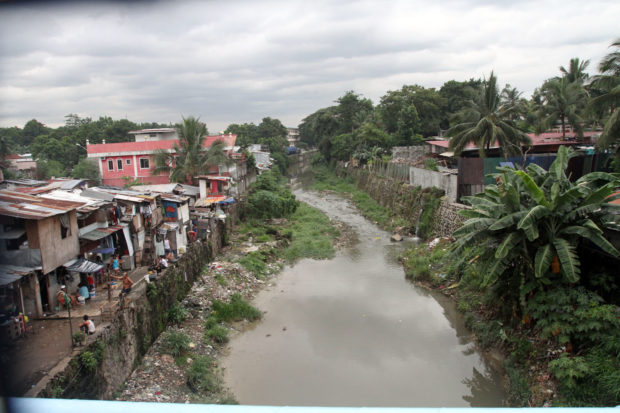Only half of target number of houses for squatters built under Aquino – COA

RESETTLEMENT The Aquino administration had ordered the construction of on-site or near-site resettlement areas for informal settlers living along waterways in Metro Manila, such as this community at North Fairview, Quezon City. —JOAN BONDOC
The Aquino administration was able to build just half the targeted number of houses for its P9.853-billion program to relocate informal settlers living in “danger zones” such as estuaries, rivers and creeks to new dwellings within Metro Manila, according to the Commission on Audit (COA).
At the same time, less than a quarter of the identified informal settler families (ISFs) actually moved to resettlement sites, the COA said in its report on the In-City Resettlement Housing Program for 2011 to 2016.
Delayed construction
In-city resettlement, which tends to be pricier but allows ISFs more access to livelihood and basic services, accounted for 17 percent of the Aquino administration’s P50-billion housing projects for 101,210 families.
The COA said only 8,644 units, or 52 percent of the 16,748 goal, were built as of Dec. 31, 2016, while 4,876 units, or 29 percent of the target, were still under construction.
Minimum floor area of a unit in a low-rise or medium-rise building for in-city resettlement is 24 square meters.
State auditors found that 22 of the 28 completed and ongoing housing projects were beset by significant time extensions of more than 25 percent, with the delay averaging 359 days.
Construction delays of 100 percent or more were observed in 11 resettlement sites. In the worst case, the 270-day duration for Paradise Heights Low-Rise Building in Tondo, Manila, was even extended by 706 days, or a 261-percent delay.
No coordination
Construction of the remaining 3,228 units, or 19 percent, had not even begun by the end of 2016, because the National Housing Authority (NHA) had yet to issue the project proposals, started the bidding processes or signed the contracts.
The COA also found that local governments did not properly coordinate with the NHA in submitting land inventory reports, compounding the agency’s problems with land scarcity.
The local governments’ failure to identify sites led to delays in the purchase of land for socialized housing.
Auditors said the resettlement goal fell short of targets, as only 3,656, or 22 percent, of the 16,748 identified ISFs were relocated.
The report found the steep 227-percent difference between the monthly payments of P3,243.02 for in-city and P992.22 for off-city units to be a disincentive for the families to transfer to the in-city sites.
Not only was there no specific timeframe to transfer, the families also found it difficult to get the required documents, such as a notarized sworn application to purchase a lot or unit, birth certificates and proof of income.
Double availment
The COA flagged the absence of an updated centralized ISF beneficiaries’ database covering all government housing programs, which hindered the validation of the in-city resettlement program beneficiaries.
This resulted in the possible double availment of housing units, as well as the accommodation of nonbeneficiaries.
Auditors randomly interviewed awardees of the housing units from eight completed projects.
In one housing project, the occupants were found to be mostly fire victims who were considered ISFs but not actually living along the priority waterways. In other words, they were “just given special accommodation” by the local government.
Some ISFs were even affected by demolition that cleared the area for resettlement. They were then allowed to occupy the units.
The COA said one factor that hindered the program was the delay of two to three years in the promulgation of policy guidelines, and implementation of rules and regulations (IRR).
Although the budget was already provided for as early as 2011, the policy guidelines and the IRR were formulated only in April 2013 and June 2014, respectively,
The roles and responsibilities of the NHA, Department of Social Welfare and Development, Social Housing Finance Corp. and local governments were not properly defined or coordinated as well.
The government also failed to tap the technical expertise of the Housing and Urban Development Coordinating Council.
While the program adopted the concept of the People’s Plan to ensure the affected families would be properly consulted, the COA noted that the selection of contractors dispensed with the consultation concept.